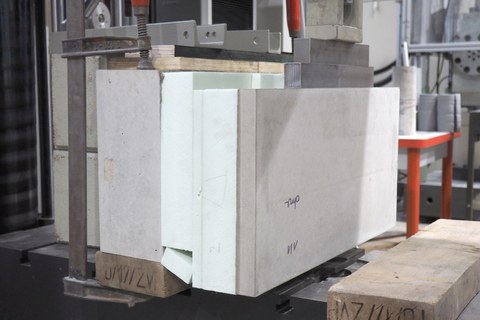C3-V4.17: Double wall system
Table of contents
Project data
|
Titel | Title |
Report in the annual report 2020
Double walls out of carbon reinforced concrete

A part of a double wall durig shear testing
The use of carbon reinforcement in new building components is steadily increasing. A major advantage of carbon reinforced concrete is that the concrete cover required for corrosion protection can be significantly minimized due to the non-metallic reinforcement. If carbon concrete is used in wall structures, for example, the wall thickness can be significantly reduced and usable space gained. Project C3-V4.17 has therefore set itself the goal of developing a double-wall system made of carbon reinforced concrete in which the wall shell thicknesses are reduced to two to four centimetres. Such a wall system is to be manufactured as a semi-finished part in a fully automated production process.
A double wall usually consists of several layers. On the outside are the thin wall shells to be produced in the precast plant. Between them are a thermal insulation layer and an area that is later filled with in-situ concrete at the construction site. To be able to prefabricate the new double-wall structure in the precast plant with dimensional accuracy, it is necessary to develop appropriate installation parts, fasteners and processes in the project that are adapted to the much thinner wall shells. The main focus was initially on the connection between the two wall shells. The requirements for the connecting material to be used here are manifold. On the one hand, it must be able to withstand the concreting pressure when the semifinished parts are cast on-site and ensure a sufficient bond in the thin wall shells. On the other hand, shear forces that may occur during transport of the semi-finished parts to the construction site must also be transmitted. When installed, the fasteners should also no longer be visible and should not cause any thermal bridges.
To meet these requirements, several concepts were developed in the project. Their performance, especially concerning load-bearing capacity, is now being investigated in laboratory tests on partial demonstrators. First of all, a test concept and a suitable test setup had to be developed. Finally, the various connection variants are to be analyzed in shear tests. After evaluation of the results, a full-scale double wall will be designed, which will then be thoroughly tested in the laboratory concerning its manufacturability in the precast plant and its load-bearing capacity.
